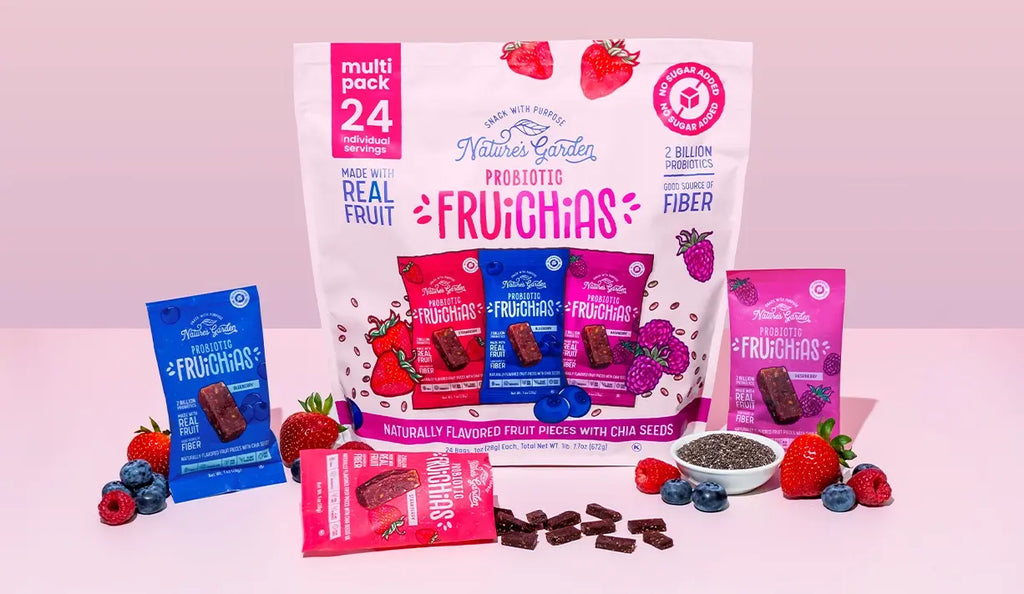The average American does not get enough fiber in their diet. In fact, a recent study published revealed that only 1 in 10 adults in the United States meet the daily recommended intake for dietary fiber. Knowing how to incorporate fiber into your diet can work wonders for your health! In this article, we are going to review the different types of fiber, the benefits of fiber for your overall health, and provide you with some tips on how to boost your daily fiber intake! Here at Nature’s Garden we value good digestive health which is why many of our products provide dietary fiber from plant compounds. Continue reading to learn more about the key nutrient, fiber!
What are the Different Types of Dietary Fiber?
Dietary fiber refers to the edible components of plants that can either be fully or partially broken down by fermentation in the large intestine, but remain undigested and unabsorbed in the small intestine.
The two main types of fiber are known as soluble and insoluble based on their solubility in hot water; both of these types contribute to good health and overall digestion.
- Soluble Fiber: reduces the rate of digestion and nutrient absorption, which leads to a lasting sensation of fullness and a reduction in hunger. Soluble fibers include pectins, beta-glucans, and oligosaccharides.
Food Sources: Apples, carrots, pears, citrus fruits, broccoli, peas, cucumbers, celery, and oat bran.
- Insoluble Fiber: moves through the digestive tract and speeds up intestinal movement, which assists the body's detoxification processes and helps to regulate bowel movements. Insoluble fibers include lignins, cellulose, hemicellulose, resistant starch, and resistant dextrin.
Food Sources: whole-grains, nuts, seeds, and skins of fruits and vegetables.
How can Fiber Improve Overall Health?
In recent decades, there has been a significant decline in the consumption of dietary fiber, resulting in harmful changes to gut microbiota. These shifts in fiber intake have played a role in the worldwide increase of obesity, type 2 diabetes, and various other metabolic conditions.
So, what are some major ways fiber can improve our health?
- Promotes Regularity: Regular bowel movements are one of the benefits of fiber. The insoluble fiber helps to prevent constipation by encouraging its passage through the digestive tract.
- Supports Gut Health: A high-fiber diet has been shown to improve the gut microbiome. Fiber is a prebiotic, providing nourishment to the beneficial bacteria in our intestines.
- Reduces Risk of Digestive Disorders: Having regular consumption of fiber can lower the risk of developing various digestive ailments, such as diverticulitis, hemorrhoids, and even colonic cancer.
- Helps Manage Weight: The feeling of fullness caused by fiber can help with weight management as individuals are less likely to overeat, and therefore more likely to maintain a healthy weight.
Current Research Among Different Cultures
- People on fiber-rich diets such as the rural/industrialized diet, Mediterranean diet, or vegetarian diet were consistently found to have a dramatically different gut microbiome than their counterparts living in developed areas.
- Recently, a Chinese adult cohort study revealed a significant correlation between a high-fiber intake of whole grains and vegetables in the habitual diet and the changes in diversity of the gut microbiome.
- Low fiber intake associated with an increased intake of saturated fat is considered to be one of the leading causes of the increased incidence of cardiovascular disease in the US compared to other countries, such as Japan and Mediterranean countries.
10 Tips to Boost Your Daily Fiber Intake
Incorporating more fiber into your diet doesn't have to be daunting. Here are some simple tips to help you boost your fiber intake:
- Eat oatmeal for breakfast or as a midday snack
- Add fresh berries to yogurt bowls
- Make stir-fries with leafy greens like kale, broccoli, and spinach
- Add chia seeds to your meals or make chia seed pudding
- Incorporate raw nuts as a daily snack
- Opt for whole grains such as brown rice, quinoa, farro, and whole-wheat bread options
- Add beans to a salad
- Spread hummus on whole-grain toast or use as a dip for vegetables
- Make smoothies with a variety of fruits and vegetables
- Switch out regular pasta for a chickpea or lentil pasta

Fiber is a fundamental aspect of digestive health and overall well-being. By understanding its types, benefits, and food sources, you can make more informed dietary choices that enhance your health.
Embracing fiber-rich foods can lead not only to better digestive health but also to greater longevity and improved quality of life. So, what are you waiting for? Give some of our products a try and start incorporating some of our helpful tips above today! One of our newest products, Fruichias, is awaiting your order. Read our recent blog post to learn more!

















